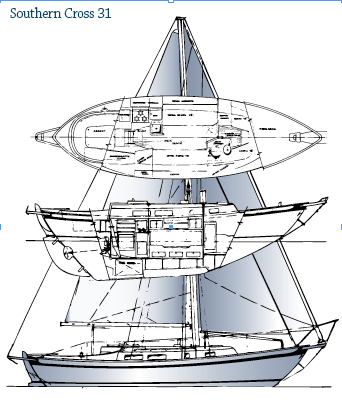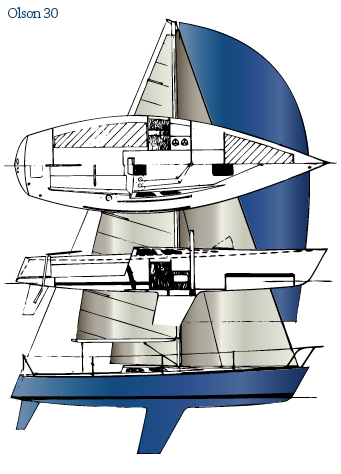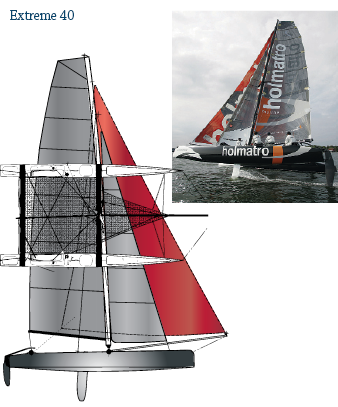Four designs that defined the times
The challenge I was given by my editors at SAILING was to go through all of my reviews and pick four for re-review. Since I've been doing design reviews for SAILING for 35 years, that's about 1,400 design reviews to pick from. I sat down with my pile of SAILING Designs books and began going through them looking for the four boats. I ruled out my own designs and chose four boats that I think are significant in that they mark trends in design. It was a tough task and I had to leave out a lot of great designs. In most cases the choices are subjective, but given the space I have here I chose boats I liked.

Robert Perry has reviewed more than 1,400 sailboat designs for SAILING since he began writing for the magazine 35 years ago. It's an astonishing number, especially when you consider that every review required careful study of plans, making various calculations based on specifications and research that often involved interviewing the designer. And then came the hard part-writing a review that accurately presented technical details while still being easily understood by readers, that praised worthy features of the boat but also criticized its shortcomings, that was fair and fun to read.
The sailing press had never seen anything quite like Bob Perry's SAILING reviews. These were not rewrites of PR copy produced by designers or builders, as was the norm in other sailing journals when Perry wrote his first review in 1975. They were critical analyses, honest and frank, giving readers essential information as "consumers" of sailboats. This took some chutzpah on the part of both Perry and SAILING. Perry, a respected yacht designer in his own right, risked irritating his peers. The magazine risked irritating advertisers. Both occasionally happened, given that the sensibilities of creative people who are as passionate about their work as designers and boatbuilders tend to be easily bruised. Readers had no such qualms, however. The Perry reviews have endured as one of the most popular features of the magazine.
Beyond its popularity, Perry's life's work as a design reviewer is a significant resource in the annals of the fiberglass era. A relative few of the 1,400-plus designs became commercial successes. Some were built only as prototypes; some not at all. For some, their fleeting moment in the attention span of sailors was the page they earned as the subject of a Bob Perry review.
Perry has been at the helm of his own Seattle-based design firm since 1974, a distinguished career that grew out of a fascination with the sea and the vessels that ply it that began in 1957, when at the age of 12 he sailed with his family to the Pacific Northwest from Australia aboard a cargo ship. Growing up, he studied and copied the great designers of the time, including Uffa Fox, William Atkin and K. Aage Nielson. By his mid-20s, Perry had invented the "performance cruiser" as designer of the revolutionary Valiant 40.
In his home-office on Puget Sound, Perry is still drawing plans for pretty, fast, seakindly boats. His latest project is a narrow, 62-foot doubled-ended daysailer being built at the Northwest School of Wooden Boatbuilding. Bob Perry's designs, like his SAILING design reviews, continue to raise the bar. --by the editors
Originally reviewed October 1975 Southern Cross 31
Cutter

In the early 1970s, the world of offshore cruising boats was dominated by double-ended types reflecting the designs of William Atkin. Atkin's double-enders were Americanizations of the Scottish designer Colin Archer's work in offshore lifeboats in Europe. The most famous of these American varieties is of course the Westsail 32, based on an early Atkin design, Eric. The general agreement at the time was that the best bluewater boats were double-enders with full keels.
The Southern Cross 31 designed by Tom Gilmer is a good example of the type.
Gilmer was a great designer. He had the eye. In a nutshell that's why I chose this design. It's a very good-looking boat with shapely ends and a nicely balanced and springy sheer. Gilmer took the Colin Archer type and flattened the buttocks, firmed up the bilges to add initial stability and added volume in the ends. The idea was to improve boat speed and reduce the Archer/Atkin type's tendency to hobbyhorse. Gilmer kept the trademark outboard rudder, an essential part of this aesthetic. The full keel is pulled back from the bow slightly but it still is a true full keel with a hefty D/L of 388 and a L/B of 3.26.
Keep in mind when you look at a design like Southern Cross that this was a time when "speed" was not a word associated with offshore cruising boats. There was a huge performance gap between the offshore boat of the day and the latest IOR "freak." The IOR boats were fast but they were considered dangerous by cruisers and not fit for offshore work. Heck, the IOR boats had fin keels and spade or skeg-hung rudders. That would never do. Of course, my Valiant 40 design changed that. It was essentially a hybrid design that bridged the gap between racers and cruisers. Someone called it a "performance-cruiser" and the term stuck. I remember an angry John Neale coming to my office with a "how dare you" attitude. John sails a nice Halberg-Rassy today with a spade rudder and fin keel. Times change.
At the beginning of the 1970s the ketch rig was considered the ultimate for most bluewater boats. But the cutter rig soon replaced the ketch as the standard rig for offshore work. The Southern Cross shows a well-proportioned cutter rig with a short, plank type bowsprit and a boomkin off the stern to get the backstay clear of the outboard rudder. It's not a big rig. The SA/D is only 12.57, so it would be very slow going in light air.
The interior layout is as simple as it could be and near perfect to my eye today. For pure functionality it's hard to beat these old orthogonal layouts.
They don't make them like this anymore but we sure made a lot of them like this back in the 1970s and 1980s.
Read the original review at: http://www.sailingmagazine.net/boats/3-perry-on-design/1096-southern-cross
LOA 31; LWL 25; Beam 9'6"; Draft 4'7"; Displacement 13,6000 lbs.; Ballast 4,100 lbs.; Sail area 496
Original sailaway price $54,900
Originally reviewed November 1978
Olson 30
Racer

I remember years ago being asked to attend a meeting of local PHRF racers to see what could be done to integrate the new "Ultra Light Displacement Boats" into the then current rating spread. As I recall the boat that had caused the trouble was the Aphrodite 101 with a D/L of around 150 and we thought that was light, even ultralight. Little did we know what was around the corner. Bruce Lee of Santa Cruz had been pushing ultralight boats for years-"Fast is Fun"-with some success but most racers saw them as downwind flyers that could not go to weather. Then George Olson designed the Olson 30 and people began to take notice. We had entered the age of the ULDB and we are still there.
I finished my original review of the Olson 30 with, "If the total criteria for a design is speed at all cost, let's have radical 60-foot catamarans or better still, one-way proas. I guess I'm becoming too much of a cruiser, but the Olson 30 appears to be a design of little versatility. We'll see."
Well, all these years later we have seen, and I was very wrong. Olson 30s are still racing today and have proven if nothing else versatile. They are fast upwind, fast downwind and on top of that, affordable and good-looking.
Read the original review at: http://www.sailingmagazine.net/component/content/article/3-perry-on-design/1095-olson-30?directory=138
LOA 30'; LWL 27'6"; Beam 9'6"; Draft 5'6"; Displacement 3,500 lbs.; Ballast 1,700 lbs;Sail area 380 sq. ft.
Original sailaway price $35,000
Originally reviewed July 1992
Alerion Express 28
Coastal cruiser

As I look back through all the volumes of SAILING Designs one of the thoughts that strikes me is where are all these designers today? Some, like my old drinking buddy Gary Mull, are dead. I didn't know Carl Schumacher well but I knew him and I was saddened when I heard he had died at such a young age. Carl had a good eye and he knew how to draw a fine sailing boat. His Express 37 remains one of my all-time favorite boats. I have no idea where some of the other designers went. I know where German Frers went. It seems that many of those confident yacht designers that were going to set the world on fire and show us how it's really done have just gone quietly away. Maybe they found real jobs.
In the mid-1990s the typical small family cruiser-racer or racer-cruiser had become a complex boat. Vendors were convincing sailors that they had to have everything in order to be happy and enjoy sailing. Ralph Schacter had another idea. He knew that most sailors went out for a day, sometimes just an afternoon or evening, and did not need things like shower stalls, refrigeration, windlasses with all-chain rode and hot-and-cold running water. But they did need a head and a place to sleep on weekend overnighters. Picking the name of Nate Herreshoff's own daysailer, Alerion, the Alerion Express was born with pretty hull lines drawn by Carl Schumacher. The era of the big, comfy daysailer had begun. I say "big" because at that time my own idea of a daysailer was a Thistle class or any number of small dinghy one-designs. Schacter's idea was that these new daysailers would be big enough to be keelboats with near the level of comfort found on the majority of production cruiser/racer types.
The look of the new daysailer would be traditional, with low freeboard, some overhangs, a svelte cabintrunk that gave slightly less than full standing headroom and a long cockpit. But below the DWL this traditional appearing boat would be modern with flat rocker, a moderate aspect ratio fin keel and a partially balanced spade rudder. The D/L of the Alerion Express 28 is 168 and the L/B is 3.46, putting it on the narrow side of "medium."
The focus on this design was the cockpit and the laying out of the running rigging so that one person could easily sail the boat. There is nothing revolutionary here except the fact that most cruiser/racer types put more emphasis on interior comfort and this resulted usually in tight, cramped cockpits. The Alerion would be tiller steered with the mainsheet led to a barney post in the center of the cockpit.
The rig is fractional with swept spreaders and a self-tacking jib. In 1994 Garry Hoyt became involved with the project at the invitation of Everett Pearson, president of TPI. Hoyt worked to refine the boat, adding his Hoyt jib boom. I really like the Hoyt boom. It is a huge improvement over the self-tacking track just so long as you don't mind this big pipe living on your foredeck. I could live with it. The SA/D is 20.97 and that's enough to keep you ghosting along in the light stuff. Hoyt also changed the keel to a fin and bulb.
I couldn't begin to tell you the boats that this design inspired. In fact, I think the Alerion Express gave birth to a type-daysailers-that today is well established and does not mean what it meant 30 years ago.
Read the original review at: http://www.sailingmagazine.net/component/content/article/3-perry-on-design/1097-alerion-express?directory=138
LOA 28'3"; LWL 22'10"; Beam 8'2"; Drat 4'6"; Ballast 2,000 lbs.; Sail area 352 sq. ft.
Original sailaway price $60,000
Originally reviewed August 2006
Extreme 40
Racing catamaran

I agonized over whether to include any multihulls in the "final four." Ian Farrier's work with folding trimarans is hard to dismiss. There is also a whole world of big cruising cats out there that did not exist 35 years ago. And to top it off, the America's Cup will be sailed in radical, 72-foot, wing-sail cats this time.
When I initially reviewed this catamaran design by Yves Loday the material focused on the Extreme racing circuit as they followed the Volvo 70s in their around-the-world race series. The Extreme 40s would show up at the finishing port and put on a show of blinding boat speed to help draw attention to the Volvo 70 series. But when you look at the list of teams that raced the Extreme 40s and compare that to the list of America's Cup teams now racing AC45 cats it occurs to me that the Extreme 40 series was maybe more of a warm-up series, getting AC skippers and crews who were more accustomed to racing fast monohulls in tune with the demands of racing a super fast big cat.
The Extreme 40's hulls are very narrow with an individual L/B of 13.6. The stems are plumb and not the wave-piercing type you see on the AC45 cats. In my initial review I said the bows are "the surface piecing type." I wonder what bow isn't "surface piercing." Clearly, when you watch the AC45s in action their bows are designed to go through the waves and not over the waves. Of course when pushed a bit too hard the leeward bow can dig in, causing very spectacular pitchpole events. I have noted that all the AC45 crews now wear helmets. The D/L for the Extreme 40 is the lowest I have calculated in 35 years of using D/Ls: 19.18 without crew and 25.46 with crew weight added.
The rig of the Extreme 40 also set the record for the highest SA/D I have ever calculated. With main, jib and crew weight the SA/D is 72.62. That's four times the horsepower-per-pound of a cruiser/racer from the mid 1970s. If you calculate the SA/D with the genniker you get an SA/D of 129.25. This type of power combined with the narrow hulls results in a top speed for the Extreme somewhere between 35 and 40 knots in 25 knots of breeze. Probably the biggest difference between the Extreme 40 and the AC45s and AC72s is that the Extreme uses conventional "soft" sails instead of the big wing we see on the AC45.
Of course capsizes will be frequent and usually spectacular as crewmembers try to cling to the webbing of the trampoline to avoid the 23-foot fall onto a nice hard piece of carbon fiber structure. I am very excited to see how all this works when it's translated into the 72-foot AC cats that will have up to 46 feet of beam. I can hardly wait.
Boats like this are only possible with extreme materials and building methods. But in the world of ultra-fast cats these methods and materials are almost commonplace now. The hulls and structural members are all carbon fiber with Nomex Aramid honeycomb cores. The Extreme is then rolled into an autoclave where a vacuum is drawn and the pieces are heated to 120 degrees Celsius. The resulting boats will be very strong but not very durable. But I like the fact that there is a class exploring the very edges of what can be done with sailing craft. Of course there are the "one-way proas" that are now sailing at over 50 knots with some really spectacular crashes. But the Extreme cat and the AC45 and AC72 will have to sail a course around buoys, upwind and down.
All this does make me wonder what the Extreme 40 cats will look like at the end of another 35 years.
Read the original review at: http://www.sailingmagazine.net/component/content/article/3-perry-on-design/1093-volvo-extreme-40?directory=138
LOA 40'; LWL 40'; Beam 23'; Draft 6'; Displacement 2,750 lbs.; Sail area 1,076 sq. ft.
Original sailaway price $385,000

Comments